|
Stages of
the Thuringian Self Pigeons
From the first mention in 1856 to recognition in 1951
As
early as 1856, Ludwig Storch named white-owled and ground-colored
pigeons among the most popular colors in Ruhla in the Thuringian
Forest. Including owls in numerous variations. The later cock-colors
can be seen in the Thuringian Selfs in Groundcoloured,
Groundcoloured Spotted (stöpflich – slight hint of check spots) and
Yellow Groundcoloured Spotted.

Fig.
1: Storch, Ludwig (anonymous), Land und Leute Nr. 5 Die Ruhl
und die Rühler, Die Gartenlaube 1856, Heft 27-29 (Country and people
No. 5 The Ruhl and the Rühler -
List of
the most popular colors in Thuringian dialect)
Afterwards, colors of the pigeons in Ruhla can be found in similar
words in the tourist guide by Alexander Ziegler in 1869. The
misprinted 'Grunzfarben' in Storch was corrected with Grundfarben =
ground color. Today, groundcoloured is the name of the exclusive
cock-colors. These pigeons are not mentioned in pigeon monographs
such as Neumeister/Prütz 1876 and others from the time.
Official recognition in 1951
The
breed was recognized equally in East and West in the German pigeon
standard in 1951. The breeders knew from experience that some colors
were only found in cocks. In the standard, light-colored,
yellow-colored and blue-colored cock-colors were singled out as
'sex-related'. All other colors including the grizzles (owls) were
open to male and females.
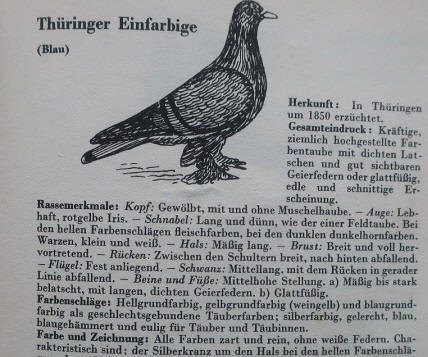

Fig.
2: Thuringian Selfs in the first standard. Origin: Thuringian about
1850.
Overall
impression: Strong, fairly high-standing color pigeon with thick
muffs and clearly visible vulture feathers, or clean legged, noble
and sleek appearance… Color-classes:
Light groundcoloured, yellow groundcoulered (wine yellow) and blue
groundcoloured as cock-colours, and silver, larked, blue, blue check
and owlish for cocks and hens.
Increase in knowledge about sexual dimorphism
In
the 1930s and 1940s, the sexually linked inherited color sexual
dimorphism by 'Faded' was discovered. The effect on males who have
the gene twice if they are pure, with a stronger lightening than on
hens who only have the gene once. Consolidated knowledge only came
to Europe with the Texans with the hereditary factor 'Faded'. These
were recognized as 'auto-sexing pioneers' in the USA in 1962. With
pure breeding, you can already tell in the nest what gender the
young are. Andreas Leiß (2000) found that the main color classes of
the Thuringian Selfs followed the same pattern of exclusive male and
exclusive hen colors. However, with a smaller color lightening
effect in both sexes, caused by 'Frosty', an allele of Faded.
Probably identical to the factor that Tim Kvidera examined in racing
pigeons in the USA.
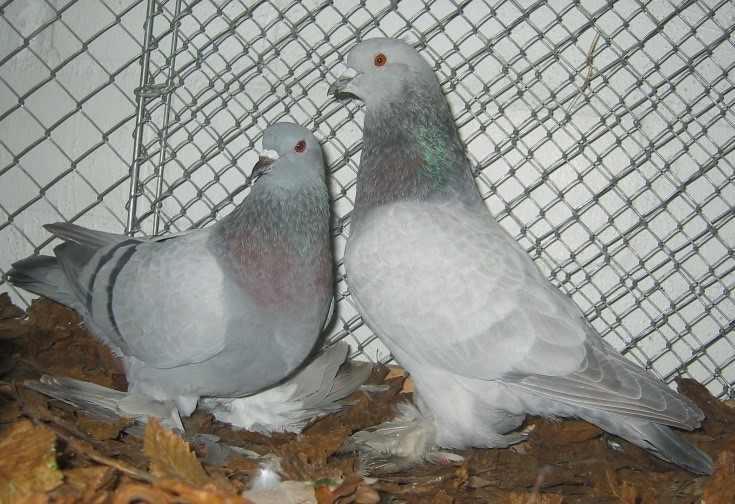
Fig.
3: Blue Groundcoloured cock (right) with his hemizygous frosty blue
bar dam (left)
The
new knowledge at the time was partially taken into account when
revising the standard (ring binder 2004) for the Thuringians. Only
partially, because as an exception to the exclusive male and hen
colors in the other color classes, grizzles in the hen color were
recognized in both sexes.
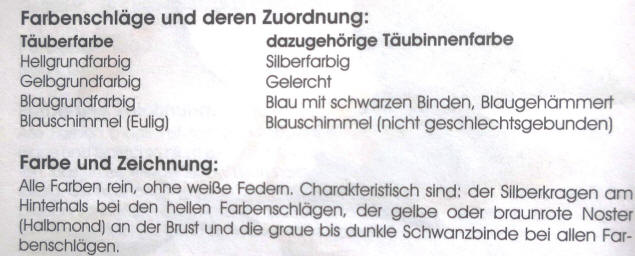
Fig.
4: Standard for Thuringian Selfs 2004
Why the exception for mold?
Thomas Oschmann from Finsterbergen in the Thuringian Forest had
already pointed out that there was also a cock color for grizzle:
the white owls or white storks. The reasons for not addressing this
when revising the standard were probably the low prevalence of
grizzles and a lack of imagination. The majority of breeders
probably couldn't imagine that homozygous-bred blue grounded cocks
would be lightened into white owls or storks due to the grizzle
factor. Even if they were heterozygous grizzle only. Apparently,
there was no willingness to investigate the question empirically.
With traditional inheritance tests one could have recreated and
understood the inheritance process in two successive pairings.
The current status: The pigeon color of the grizzles in the AOC-Class
The
inheritance process can also be traced today using the family trees
when Frank Zetzsche re-bred the clean-legged Thuringian grizzles.
The first grizzle cocks that are homozygous for Frosty will probably
be seen at the upcoming Lipsia 2023 in the AOC class in clean-legged
and short muffed as 'white storks'. Paradox to find a pure
cock-color in a sex-dimorph breed in the AOC class instead of in the
regular class.
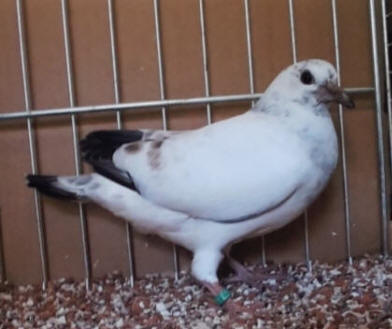 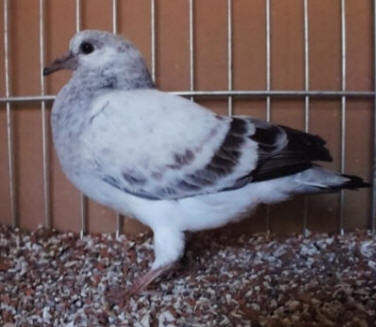
Fig. 5:
Sex-Dimorph Thuringian Selfs clean-legged. Cock- and hen color in
grizzles, homozygous Frosty male (left) and hemizygous Frosty hen,
both heterozygous grizzles. Photos and
breeding Frank Zetzsche
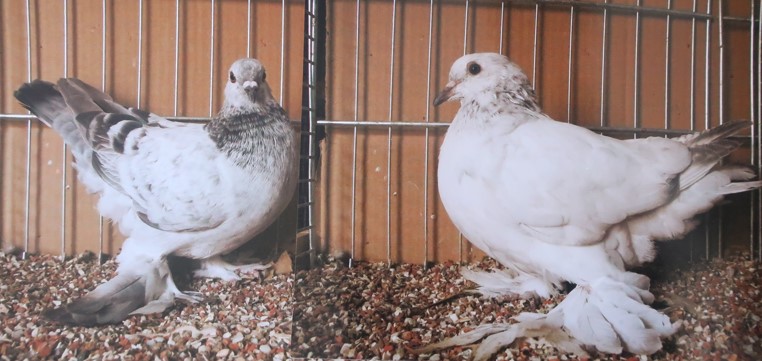
Fig.
6: Sex-Dimorph Thuringian Selfs. Cock and hen colour in grizzles,
homozygous Frosty male (right) and hemizygote Frosty hen,
both
heterozygous grizzles.
Photos and
breeding Frank Zetzsche
Literature:
Ilgen, H., und
Bernd Herbold, 100 Jahre Sonderverein der Thüringer Farbentauben,
Sonneberg 2010.
Sell, A.,
Genetik der Taubenfärbungen, Achim 2015.
Sell, A., Pigeon Genetics. Applied Genetics in the Domestic Pigeon,
Achim 2012.
Sell, A. und
J., Vererbung bei Tauben, Reutlingen 2007.
Storch, Ludwig
(anonym), Land und Leute Nr. 5 Die Ruhl und die Rühler, Die
Gartenlaube 1856, Heft 27-29, S. 352-355, 374-376, 386-388.
Ziegler, Alexander, Das Thüringerwalddorf
Ruhla und seine Umgebung, Dresden 1867 (Reprint)
|